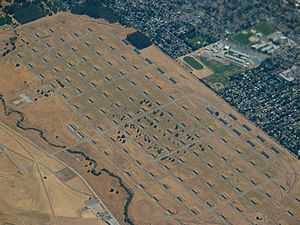- Concord Naval Weapons Station
-
Concord Naval Weapons Station Concord, California 
Aerial view taken in 2006Type Military base Built 1942 Controlled by United States Navy Events Port Chicago disaster Coordinates: 37°59′39″N 121°58′58″W / 37.99417°N 121.98278°W[1]
Concord Naval Weapons Station was a military base established in 1942 north of the city of Concord, California at the shore of the Sacramento River where it widens into Suisun Bay. The station functioned as a World War II armament storage depot, supplying ships at Port Chicago. The Concord NWS continued to support war efforts during the Korean War, the Vietnam War and the Gulf War, processing and shipping thousands of tons of materiel out across the Pacific Ocean.[2]
The station consisted of two areas: the Inland Area (5,028 acres (20 km2)), which is within the Concord city limits, and the Tidal Area (7,630 acres (31 km2)).[3] Because of changes in military operations, parts of the Inland Area began to be mothballed, and by 1999 the station had only a minimal contingent of military personnel and contained mainly empty ammunition storage bunkers, empty warehouses, and disused support structures. In 2007 the U.S. Federal Government announced that the Inland Area of the Naval station would be closed. The Tidal area of the base was not scheduled for closure.[2]
The City of Concord, sitting as the Federally designated Local Reuse Authority, is in the process of formulating a Reuse Plan for the Inland Area that includes residential and commercial development while reserving approximately two-thirds for open-space and parks projects.[4] The Reuse Plan is subject to approval by the Navy.[3][5]
Contents
Port Chicago disaster
Main article: Port Chicago disasterIn 1944, thousands of tons of munitions aboard a Navy cargo ship exploded while being loaded, resulting in the largest number of casualties among African Americans in any one incident during World War II. On the evening of July 17, a massive explosion instantly killed 320 sailors, merchant seamen and civilians working at the pier. The blast was felt 30 miles away. A subsequent refusal by 258 black sailors to load any more ammunition was the beginning of the Navy's largest-ever mutiny trial in which 50 men were found guilty. Future Supreme Court Justice Thurgood Marshall sat in on most of the proceedings and declared that he saw a prejudiced court.[6]
War protests
In 1987, at the height of U.S. intervention in the Central American Crisis, Concord Naval Weapons Station was the site of daily anti-war protests against the shipment of weapons to Central America, including white phosphorus. On September 1, 1987 U.S. Air Force veteran and peace activist Brian Willson was run over by a Navy munitions train while unlawfully attempting to stop the train outside the compound gates. He suffered a fractured skull and the amputation of both his legs below the knee, among other injuries. In the days afterward, thousands participated by protesting the actions of the train's crew and the munitions shipment including Jesse Jackson and Joan Baez. During the demonstration, anti-war protesters dismantled several hundred feet of Navy railroad tracks located outside of the base, while police and U.S. Marines looked on. Billy Nessen, a prominent Berkeley-based activist, was subsequently charged with organizing the track removal, and his trial resulted in a plea bargain that involved no jail time. The authorities responsible for causing Willson's injury were never prosecuted in criminal court, but a civil suit was filed and an out-of-court settlement was awarded.
Superfund cleanup site
The Concord NWS was listed as a Superfund cleanup site on December 16, 1994. 32 areas of the facility were identified as having been contaminated with heavy metals including zinc, copper, lead, cadmium, and arsenic, as well as semi-volatile organic compounds (SVOC) and organochloride pesticides. An area of great concern is the risk to the endangered the Salt Marsh Harvest Mouse and the California Clapper Rail. Environmental remediation is underway at the base with some sites having soil removed and others being capped to prevent spread of contaminants.[7][8]
Current operations
In 2008 control of the site was changed. The Inland Area became a Detachment of the Naval Weapons Station Seal Beach, pending ultimate closure. The Tidal Area was transferred to the U.S. Army Surface Deployment and Distribution Command (SDDC) and is now known as Military Ocean Terminal Concord (MOTCO). This facility was also used by the Diablo Squadron and Training Ship Concord of the United States Naval Sea Cadet Corps
See also
- Mare Island Naval Shipyard
- Parks Reserve Forces Training Area
- Port Chicago Naval Magazine National Memorial
References
- ^ United States Geological Survey (17 November 2008). "GNIS Detail - Naval Weapons Station Concord". Geographic Names Information System. United States Geological Survey. http://geonames.usgs.gov/pls/gnispublic/f?p=gnispq:3:::NO::P3_FID:2511957. Retrieved 2010-01-01.
- ^ a b Concord Navel Weapons Station Reuse Information Portal. Retrieved 2007-08-13
- ^ a b About the City of Concord Community Reuse Project, official city web site'. Retrieved 2007-08-13
- ^ "Concord Reuse Project". Official Reuse Project website. Retrieved 2010-01-26
- ^ "Concord Naval Weapons Station". Contra Costa Times website collection of articles. Retrieved 2007-08-13
- ^ Allen, Robert L. (2006). The Port Chicago Mutiny. Berkeley, CA: Heyday Books. p. 118. ISBN 9781597140287. OCLC 63179024. http://books.google.com/books?id=2jl6cyAy6u8C.
- ^ "NPL Site Narrative for Concord Naval Weapons Station". National Priorities List. Environmental Protection Agency. February 24, 2006. http://www.epa.gov/superfund/sites/npl/nar1344.htm. Retrieved 2007-08-13.
- ^ "Concord Naval Weapons Station". Region 9: Superfund. Environmental Protection Agency. http://yosemite.epa.gov/r9/sfund/r9sfdocw.nsf/2e3c0ceec080b048882573290078b56a/cc5e3a039784839788257007005e93f3!OpenDocument. Retrieved 2007-08-13.
External links
Categories:- History of Contra Costa County, California
- United States Navy bases
- United States Navy shipyards
- National Historic Landmarks in the San Francisco Bay Area
- Naval architecture
- Military Superfund sites
- Buildings and structures in Contra Costa County, California
Wikimedia Foundation. 2010.
